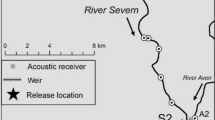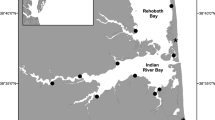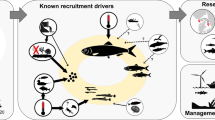Abstract
Demographic, functional, or habitat diversity can confer stability on populations via portfolio effects (PEs) that integrate across multiple ecological responses and buffer against environmental impacts. The prevalence of these PEs in aquatic organisms is as yet unknown, and can be difficult to quantify; however, understanding mechanisms that stabilize populations in the face of environmental change is a key concern in ecology. Here, we examine PEs in Pacific herring (Clupea pallasii) in Puget Sound (USA) using a 40-year time series of biomass data for 19 distinct spawning population units collected using two survey types. Multivariate auto-regressive state-space models show independent dynamics among spawning subpopulations, suggesting that variation in herring production is partially driven by local effects at spawning grounds or during the earliest life history stages. This independence at the subpopulation level confers a stabilizing effect on the overall Puget Sound spawning stock, with herring being as much as three times more stable in the face of environmental perturbation than a single population unit of the same size. Herring populations within Puget Sound are highly asynchronous but share a common negative growth rate and may be influenced by the Pacific Decadal Oscillation. The biocomplexity in the herring stock shown here demonstrates that preserving spatial and demographic diversity can increase the stability of this herring population and its availability as a resource for consumers.






Similar content being viewed by others
References
Agashe D (2009) The stabilizing effect of intraspecific genetic variation on population dynamics in novel and ancestral habitats. Am Nat 174:255–267. doi:10.1086/600085
Anderson EM, Lovvorn JR, Esler D et al (2009) Using predator distributions, diet, and condition to evaluate seasonal foraging sites: sea ducks and herring spawn. Mar Ecol Prog Ser 386:287–302. doi:10.3354/meps08048
Anderson SC, Cooper AB, Dulvy NK (2013) Ecological prophets: quantifying metapopulation portfolio effects. Methods Ecol Evol 4:971–981. doi:10.1111/2041-210x.12093
Beaudreau AH, Essington TE (2011) Use of pelagic prey subsidies by demersal predators in rocky reefs: insight from movement patterns of lingcod. Mar Biol 158:471–483. doi:10.1007/s00227-010-1574-6
Burton SF (1990) Comparison of Pacific spawner herring biomass estimates from hydroacoustic-trawl and spawning ground escapement surveys in Puget Sound, Washington
Casini M, Kornilovs G, Cardinale M et al (2011) Spatial and temporal density dependence regulates the condition of central Baltic Sea clupeids: compelling evidence using an extensive international acoustic survey. Popul Ecol 53:511–523. doi:10.1007/s10144-011-0269-2
Cavanaugh JE, Shumway RH (1997) A bootstrap variant of AIC for state-space model selection. Stat Sin 7:473–496
Chapman WM, Katz M, Erickson DW et al (1941) The races of herring in the state of Washington
Doak DF, Bigger D, Harding EK et al (1998) The statistical inevitability of stability-diversity relationships in community ecology. Am Nat 151:264–276. doi:10.1086/286117
Duffy EJ, Beauchamp DA, Sweeting RM et al (2010) Ontogenetic diet shifts of juvenile chinook salmon in nearshore and offshore habitats of Puget Sound. Trans Am Fish Soc 139:803–823. doi:10.1577/t08-244.1
Grabowski TB, Thorsteinsson V, McAdam BJ, Marteinsdóttir G (2011) Evidence of segregated spawning in a single marine fish stock: sympatric divergence of ecotypes in Icelandic cod? PLoS One 6:e17528. doi:10.1371/journal.pone.0017528
Hanski I (1999) Metapopulation ecology. Oxford University Press, Oxford, New York
Hare SR, Mantua NJ, Francis RC (1999) Inverse production regimes: Alaska and West Coast Pacific Salmon. Fisheries 24:6–14. doi:10.1577/1548-8446
Hatch S (2013) Kittiwake diets and chick production signal a 2008 regime shift in the Northeast Pacific. Mar Ecol Prog Ser 477:271–284. doi: 10.3354/meps10161
Hay DE, McCarter PB, Daniel KS (2001) Tagging of Pacific herring Clupea pallasii from 1936 to 1992: a review with comments on homing, geographic fidelity, and straying. Can J Fish Aquat Sci 58:1356–1370. doi:10.1139/cjfas-58-7-1356
Hinrichsen R, Holmes E (2009) Using multivariate state-space models to study spatial structure and dynamics. In: Cantrell R, Cosner C, Ruan S (eds) Spatial ecology. CRC/Chapman Hall, Boca Raton, pp 145–166
Holmes EE (2014) Derivation of an EM algorithm for constrained and unconstrained multivariate autoregressive state-space (MARSS) models. arXiv preprint arXiv:1302.3919
Holmes EE, Ward EJ, Wills K (2012) Marss: multivariate autoregressive state-space models for analyzing time-series data. R J 4:11–19
Hooper DU, Chapin FS, Ewel JJ et al (2005) Effects of biodiversity on ecosystem functioning: a consensus of current knowledge. Ecol Monogr 75:3–35. doi:10.1890/04-0922
Hutchinson WF (2008) The dangers of ignoring stock complexity in fishery management: the case of the North Sea cod. Biol Lett 4:693–695. doi:10.1098/rsbl.2008.0443
Hutchinson WF, Carvalho GR, Rogers SI (2001) Marked genetic structuring in localised spawning populations of cod Gadus morhua in the North Sea and adjoining waters, as revealed by microsatellites. Mar Ecol Prog Ser 223:251–260. doi:10.3354/meps223251
Ives AR, Dennis B, Cottingham KL, Carpenter SR (2003) Estimating community stability and ecological interactions from time series data. Ecol Monogr 73:301–330. doi:10.1890/0012-9615(2003)073[0301:ECSAEI]2.0.CO;2
Lance MM, Jeffries SJ (2006) Estimating importance of rockfish, lingcod and other bottomfish in the diet of harbor seals in the San Juan Islands. Washington Department of Fish and Wildlife, Olympia
Lehman CL, Tilman D (2000) Biodiversity, stability, and productivity in competitive communities. Am Nat 156:534–552. doi:10.1086/303402
Levin SA (1992) The problem of pattern and scale in ecology. Ecology 73:1943–1967. doi:10.2307/1941447
Lindegren M, Andersen KH, Casini M, Neuenfeldt S (2014) A metacommunity perspective on source–sink dynamics and management: the Baltic Sea as a case study. Ecol Appl 24:1820–1832. doi:10.1890/13-0566.1
Loreau M, de Mazancourt C (2008) Species synchrony and its drivers: neutral and nonneutral community dynamics in fluctuating environments. Am Nat 172:E48–E66. doi:10.1086/589746
MacArthur R (1955) Fluctuations of animal populations and a measure of community stability. Ecology 36:533–536. doi:10.2307/1929601
McArdle BH, Gaston KJ, Lawton JH (1990) Variations in the size of animal populations—patterns, problems and artifacts. J Anim Ecol 59:439–454. doi:10.2307/4873
McQuinn IH (1997) Metapopulations and the Atlantic herring. Rev Fish Biol Fish 7:297–329. doi:10.1023/a:1018491828875
Michener WK, Baerwald TJ, Firth P et al (2001) Defining and unraveling biocomplexity. Bioscience 51:1018–1023. doi:10.1641/0006-3568(2001)051[1018:DAUB]2.0.CO;2
National Marine Fisheries Service Fisheries Statistics and Economics Division (2013) Current Fisheries Statistics No. 2013
Penttila D (2007) Marine forage fishes in Puget Sound. Washington Department of Fish and Wildlife
Reum JCP, Essington TE, Greene CM et al (2011) Multiscale influence of climate on estuarine populations of forage fish: the role of coastal upwelling, freshwater flow and temperature. Mar Ecol Prog Ser 425:203–215. doi:10.3354/meps08997
Schindler DE, Hilborn R, Chasco B et al (2010) Population diversity and the portfolio effect in an exploited species. Nature 465:609–612. doi:10.1038/nature09060
Schindler DE, Armstrong JB, Bentley KT et al (2013) Riding the crimson tide: mobile terrestrial consumers track phenological variation in spawning of an anadromous fish. Biol Lett 9:20130048. doi:10.1098/rsbl.2013.0048
Schindler DE, Armstrong JB, Reed TE (2015) The portfolio concept in ecology and evolution. Front Ecol Environ 13:257–263. doi:10.1890/140275
Schrimpf MB, Parrish JK, Pearson SF (2012) Trade-offs in prey quality and quantity revealed through the behavioral compensation of breeding seabirds. Mar Ecol Prog Ser 460:247–259. doi:10.3354/meps09750
Schweigert J, Haegele C (2001) Estimates of egg loss in Pacific herring spawning beds and its impact on stock assessments. University of Alaska Sea Grant College Program report herring: expectations for a new millennium AK-SG-01-04:489–508
Shelton AO, Francis TB, Williams GD et al (2014) Habitat limitation and spatial variation in Pacific herring egg survival. Mar Ecol Prog Ser 514:231–245. doi:10.3354/meps10941
Small MP, Loxterman JL, Frye AE et al (2005) Temporal and spatial genetic structure among some Pacific herring populations in Puget Sound and the southern Strait of Georgia. Trans Am Fish Soc 134:1329–1341. doi:10.1577/t05-050.1
Stick K, Lindquist A, Lowry D (2014) 2012 Washington State herring stock status report
Stout HA, Gustafson RG, Lenarz WH et al (2001) Status review of Pacific herring (Clupea pallasii) in Puget Sound, Washington
Thorson JT, Scheuerell MD, Buhle ER, Copeland T (2014) Spatial variation buffers temporal fluctuations in early juvenile survival for an endangered Pacific salmon. J Anim Ecol 83:157–167. doi:10.1111/1365-2656.12117
Trites AW, Calkins DG, Winship AJ (2007) Diets of Steller sea lions (Eumetopias jubatus) in Southeast Alaska, 1993-1999. Fishery Bulletin 105:234–248
Ward EJ, Chirakkal H, Gonzalez-Suarez M et al (2010) Inferring spatial structure from time-series data: using multivariate state-space models to detect metapopulation structure of California sea lions in the Gulf of California, Mexico. J Appl Ecol 47:47–56. doi:10.1111/j.1365-2664.2009.01745.x
Ware D, Schweigert J (2001) Metapopulation structure and dynamics of British Columbia herring. Department of Fisheries and Oceans, Ottowa
West JE, O’Neill SM, Ylitalo GM (2008) Spatial extent, magnitude, and patterns of persistent organochlorine pollutants in Pacific herring (Clupea pallasii) populations in the Puget Sound (USA) and Strait of Georgia (Canada). Sci Total Environ 394:369–378. doi:10.1016/j.scitotenv.2007.12.027
Zebdi A, Collie JS (1995) Effect of climate on herring (Clupea pallasii) population dynamics in the Northeast Pacific Ocean. Can Spec Publ Fish Aquat Sci 121:277–290
Acknowledgments
The authors would like to thank E. E. Holmes, M. D. Scheuerell, E. J. Ward, D. E. Schindler, A. O. Shelton and two anonymous reviewers for reviewing earlier versions of this manuscript. We thank Kurt Stick, Adam Lindquist and Dayv Lowry at the Washington Department of Fish and Wildlife for data and for their insight on Puget Sound Pacific herring, and Kiva Oken for assistance with simulating correlated time series. M. C. Siple was supported by an NSF Graduate Research Fellowship and a fellowship from the University of Washington School of Aquatic and Fishery Sciences. This document has been funded wholly or in part by the United States Environmental Protection Agency under assistance agreement 00J30301-0 to the University of Washington. The contents of this document do not necessarily reflect the views and policies of the Environmental Protection Agency, nor does mention of trade names or commercial products constitute endorsement or recommendation for use.
Author contribution statement
T. B. F. conceived the study, M. C. S. designed model selection procedures and performed the analysis. M. C. S. and T. B. F. wrote the manuscript.
Author information
Authors and Affiliations
Corresponding author
Ethics declarations
Ethical approval
This article does not contain any studies with human participants or animals performed by any of the authors.
Conflict of interest
The authors declare that they have no conflict of interest.
Additional information
Communicated by Brian Shuter.
Electronic supplementary material
Below is the link to the electronic supplementary material.
Rights and permissions
About this article
Cite this article
Siple, M.C., Francis, T.B. Population diversity in Pacific herring of the Puget Sound, USA. Oecologia 180, 111–125 (2016). https://doi.org/10.1007/s00442-015-3439-7
Received:
Accepted:
Published:
Issue Date:
DOI: https://doi.org/10.1007/s00442-015-3439-7




